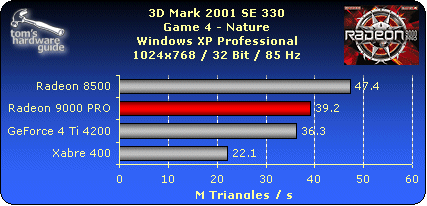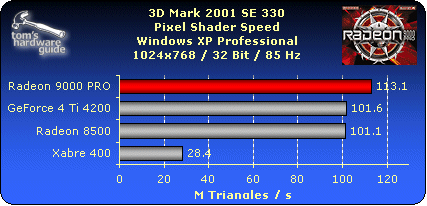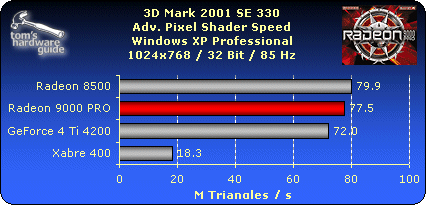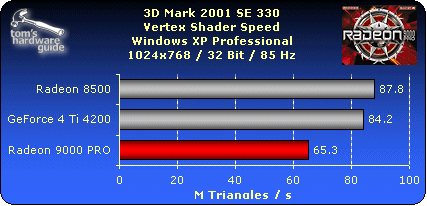The new mainstream Radeon: The 9000 series
Game 4 Nature Test

This is a stress test for the cards because it involves a high polygon count and pixel shader effects. Here, the Radeon cards show their strengths and are even able to put a GeForce4 Ti4200 in its place. The Xabre 400 falls behind all too clearly. MX 460 and 400 aren't included in this test at all, since they lack pixel shaders.
Pixel Shader Speed

In this test, the R9000 is able to get ahead of the competition. The Xabre 400 reveals that its pixel shader unit is nothing more than empty marketing jargon, at least in the 3D Mark 2001 Pixel Shader tests.
Adv. Pixel Shader Speed

The results of this test can only be compared indirectly, since it runs on ATI cards with pixel shader version 1.4, but not with version 1.1. In this test, the ATI cards have the advantage, because calculation of the water (per pixel) can be processed in a single clock cycle, thanks to support from the pixel shader standard 1.4. Cards with pixel shader 1.3 require two clock cycles. Despite this theoretical advantage, ATI boards are only a nose ahead of the Ti 4200. The Xabre lags hopelessly behind.
Vertex Shader Speed

There's hardly any evidence of the R9000's optimized vertex shaders that ATI talks about. The performance is clearly poorer than the R8500. Again, the reason for this might be found in the test mode of 3D Mark 2001.
Stay on the Cutting Edge
Join the experts who read Tom's Hardware for the inside track on enthusiast PC tech news — and have for over 25 years. We'll send breaking news and in-depth reviews of CPUs, GPUs, AI, maker hardware and more straight to your inbox.
Current page: Game 4 Nature Test
Prev Page 3D Mark 2001 Detail Next Page Conclusion: Radeon 9000 PROMost Popular

